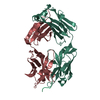Entry Database : PDB / ID : 8og0Title Crystal structure of MJF14-6-4-2 Fab fragment in complex with epitope peptide Alpha-synuclein Fab fragment heavy chain Fab fragment light chain Keywords / / / / Function / homology Function Domain/homology Component
/ / / / / / / / / / / / / / / / / / / / / / / / / / / / / / / / / / / / / / / / / / / / / / / / / / / / / / / / / / / / / / / / / / / / / / / / / / / / / / / / / / / / / / / / / / / / / / / / / / / / / / / / / / / / Biological species Oryctolagus cuniculus (rabbit)Homo sapiens (human)Method / / / Resolution : 1.712 Å Authors Tars, K. / Lieknina, I. Funding support European Union, 1items Organization Grant number Country European Union (EU) OligoFIT European Union
Journal : NPJ Parkinsons Dis / Year : 2024Title : Structural basis of epitope recognition by anti-alpha-synuclein antibodies MJFR14-6-4-2.Authors : Lieknina, I. / Reimer, L. / Pantelejevs, T. / Lends, A. / Jaudzems, K. / El-Turabi, A. / Gram, H. / Hammi, A. / Jensen, P.H. / Tars, K. History Deposition Mar 17, 2023 Deposition site / Processing site Revision 1.0 Mar 27, 2024 Provider / Type Revision 1.1 Nov 6, 2024 Group / Structure summaryCategory citation / citation_author ... citation / citation_author / pdbx_entry_details / pdbx_modification_feature Item _citation.journal_abbrev / _citation.journal_id_CSD ... _citation.journal_abbrev / _citation.journal_id_CSD / _citation.journal_id_ISSN / _citation.journal_volume / _citation.page_first / _citation.page_last / _citation.pdbx_database_id_DOI / _citation.pdbx_database_id_PubMed / _citation.title / _citation.year
Show all Show less
 Yorodumi
Yorodumi Open data
Open data Basic information
Basic information Components
Components Keywords
Keywords Function and homology information
Function and homology information
 Homo sapiens (human)
Homo sapiens (human) X-RAY DIFFRACTION /
X-RAY DIFFRACTION /  SYNCHROTRON /
SYNCHROTRON /  MOLECULAR REPLACEMENT / Resolution: 1.712 Å
MOLECULAR REPLACEMENT / Resolution: 1.712 Å  Authors
Authors Citation
Citation Journal: NPJ Parkinsons Dis / Year: 2024
Journal: NPJ Parkinsons Dis / Year: 2024 Structure visualization
Structure visualization Molmil
Molmil Jmol/JSmol
Jmol/JSmol Downloads & links
Downloads & links Download
Download 8og0.cif.gz
8og0.cif.gz PDBx/mmCIF format
PDBx/mmCIF format pdb8og0.ent.gz
pdb8og0.ent.gz PDB format
PDB format 8og0.json.gz
8og0.json.gz PDBx/mmJSON format
PDBx/mmJSON format Other downloads
Other downloads https://data.pdbj.org/pub/pdb/validation_reports/og/8og0
https://data.pdbj.org/pub/pdb/validation_reports/og/8og0 ftp://data.pdbj.org/pub/pdb/validation_reports/og/8og0
ftp://data.pdbj.org/pub/pdb/validation_reports/og/8og0 F&H Search
F&H Search Links
Links Assembly
Assembly
 Components
Components



 Homo sapiens (human) / References: UniProt: P37840
Homo sapiens (human) / References: UniProt: P37840 X-RAY DIFFRACTION / Number of used crystals: 1
X-RAY DIFFRACTION / Number of used crystals: 1  Sample preparation
Sample preparation SYNCHROTRON / Site:
SYNCHROTRON / Site:  Diamond
Diamond  / Beamline: I03 / Wavelength: 0.976254 Å
/ Beamline: I03 / Wavelength: 0.976254 Å Processing
Processing MOLECULAR REPLACEMENT / Resolution: 1.712→83.58 Å / Cor.coef. Fo:Fc: 0.952 / Cor.coef. Fo:Fc free: 0.936 / SU B: 3.525 / SU ML: 0.106 / Cross valid method: THROUGHOUT / ESU R: 0.171 / ESU R Free: 0.151 / Stereochemistry target values: MAXIMUM LIKELIHOOD / Details: HYDROGENS HAVE BEEN ADDED IN THE RIDING POSITIONS
MOLECULAR REPLACEMENT / Resolution: 1.712→83.58 Å / Cor.coef. Fo:Fc: 0.952 / Cor.coef. Fo:Fc free: 0.936 / SU B: 3.525 / SU ML: 0.106 / Cross valid method: THROUGHOUT / ESU R: 0.171 / ESU R Free: 0.151 / Stereochemistry target values: MAXIMUM LIKELIHOOD / Details: HYDROGENS HAVE BEEN ADDED IN THE RIDING POSITIONS Movie
Movie Controller
Controller


 PDBj
PDBj

